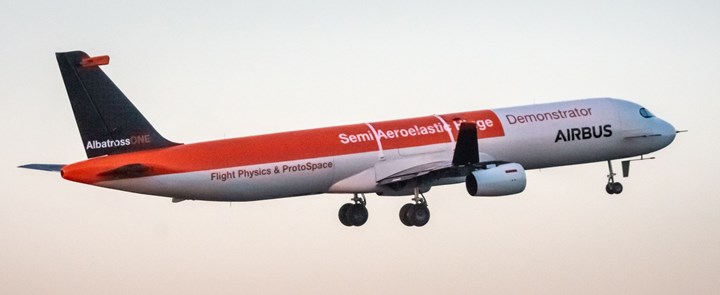Airbus Albatross features flapping wings made from composites
Airbus demonstrates first in-flight, flapping wing-tips that could revolutionize aircraft wing and wing box design.
Airbus engineers have developed a scale-model aircraft with the first in-flight, flapping wing-tips that could revolutionize aircraft wing-design. The company has drawn on nature to develop its ‘semi-aeroelastic hinge’ concept to reduce drag and overall wing weight, while combating the effects of turbulence and wind gusts.
Known as AlbatrossOne, the remote-controlled aircraft has already taken its first flights to prove the concept and the team will now conduct further testing before the demonstrator, based on the manufacturer’s A321 plane, is scaled-up further.

The first test flights of the AlbatrossOne demonstrator, developed by Airbus engineers in Filton, were concluded in February after a 20-month development program. SOURCE | Airbus
“While hinged wing-tips are not new – military jets employ them to allow greater storage capacity on aircraft carriers – the Airbus demonstrator is the first aircraft to trial in-flight, freely-flapping wing-tips to relieve the effects of wind gusts and turbulence,” explained Airbus engineer Tom Wilson, based in Filton, north Bristol, UK. “We drew inspiration from nature – the albatross marine bird locks its wings at the shoulder for long-distance soaring but unlocks them when wind-gusts occur or maneuvering is required.”
“The AlbatrossOne model will explore the benefits of unlockable, freely-flapping wing-tips – accounting for a up to a third of the length of the wing – to react autonomously during in-flight turbulence and lessen the load on the wing at its base, so reducing the need for heavily reinforced wing boxes,” added Wilson.
“When there is a wind gust or turbulence, the wing of a conventional aircraft transmits huge loads to the fuselage, so the base of the wing must be heavily strengthened, adding weight to the aircraft,” explained Jean-Brice Dumont, Airbus’ executive VP of Engineering. “Allowing the wing-tips to react and flex to gusts reduces the loads and allows us to make lighter and longer wings – the longer the wing, the less drag it creates up to an optimum, so there are potentially more fuel efficiencies to exploit.” Dumont also noted that AlbatrossOne is the “first Filton aircraft since Concorde”.
The demonstrator has been constructed from carbon fiber- and glass fiber-reinforced polymer composites, as well as components from additive-layer manufacturing. The first test flights were concluded in February after a 20-month development program. Initial testing of AlbatrossOne has examined the demonstrator’s stability with the wing-tips locked and completely unlocked, says Filton engineer James Kirk. “The next step is to conduct further tests to combine the two modes, allowing the wing-tips to unlock during flight and to examine the transition,” he added.
The team presented their research at the International Forum on Aeroelasticity and Structural Dynamics conference in the United States this week.
Related Content
-
Plant tour: Teijin Carbon America Inc., Greenwood, S.C., U.S.
In 2018, Teijin broke ground on a facility that is reportedly the largest capacity carbon fiber line currently in existence. The line has been fully functional for nearly two years and has plenty of room for expansion.
-
The lessons behind OceanGate
Carbon fiber composites faced much criticism in the wake of the OceanGate submersible accident. CW’s publisher Jeff Sloan explains that it’s not that simple.
-
Natural fiber composites: Growing to fit sustainability needs
Led by global and industry-wide sustainability goals, commercial interest in flax and hemp fiber-reinforced composites grows into higher-performance, higher-volume applications.
















